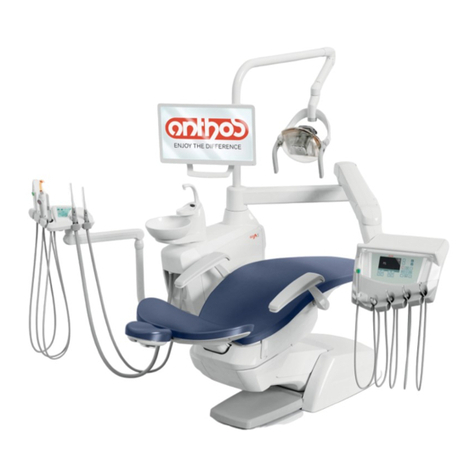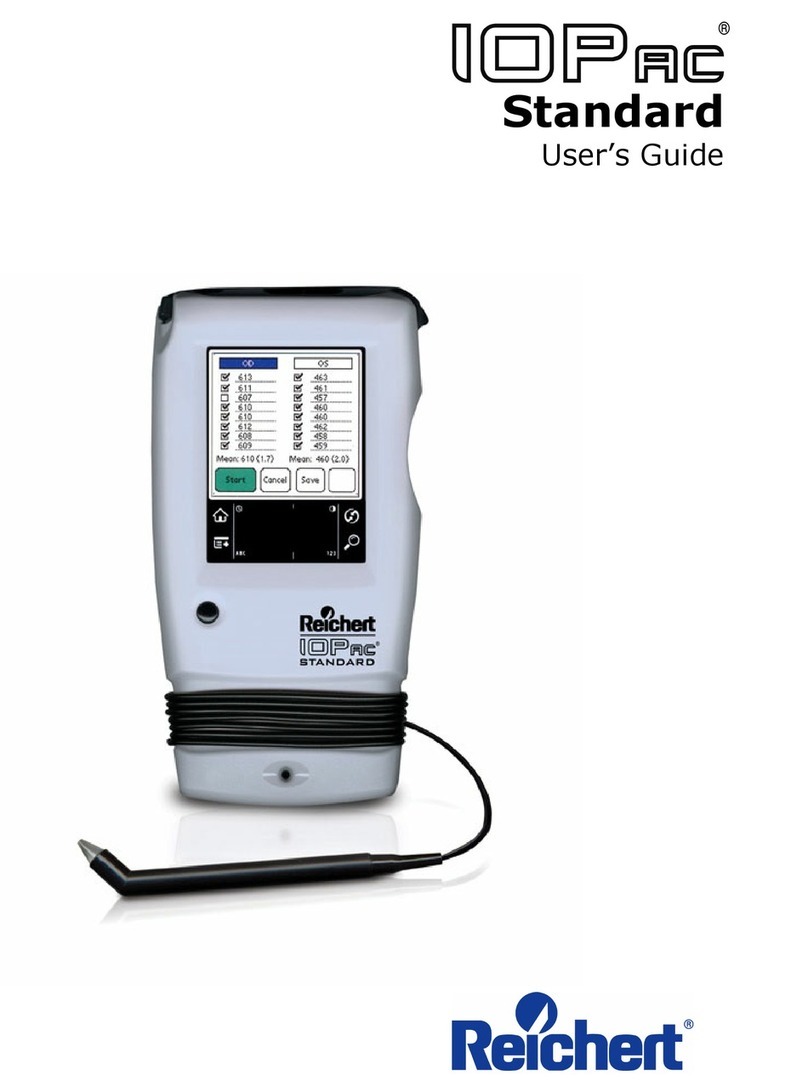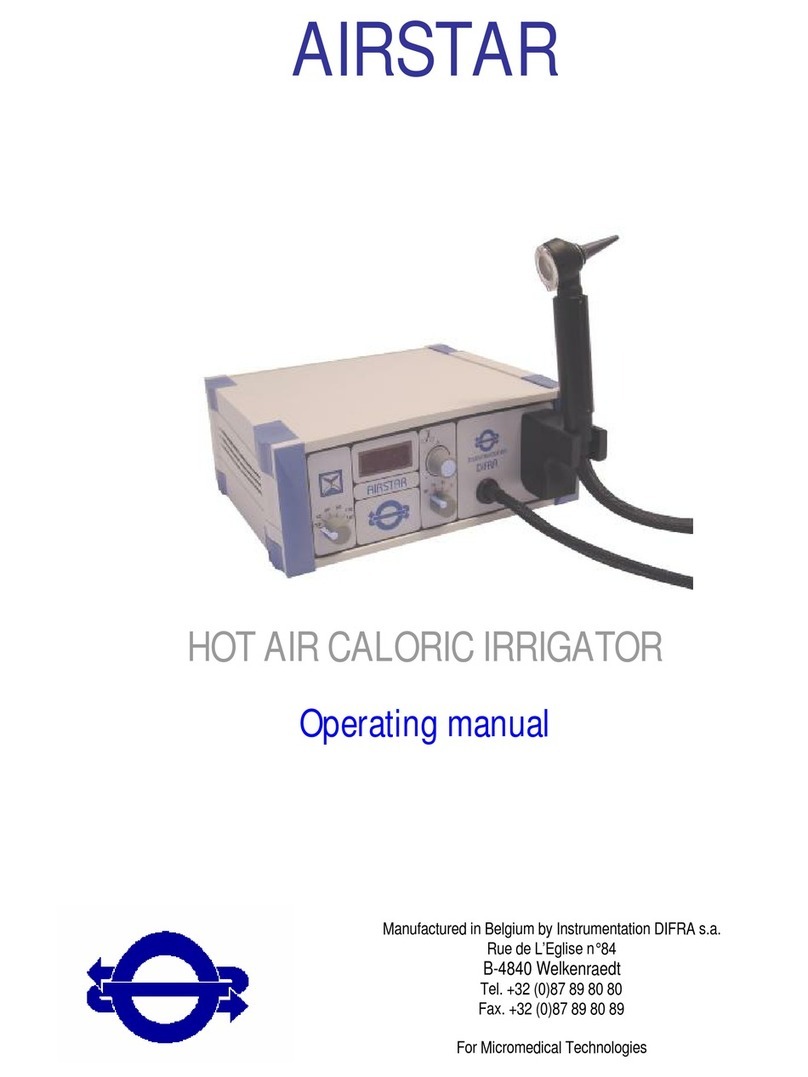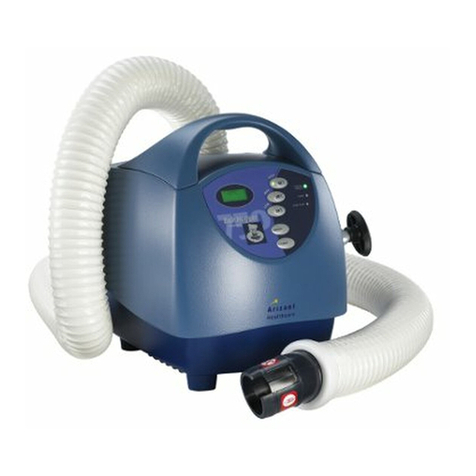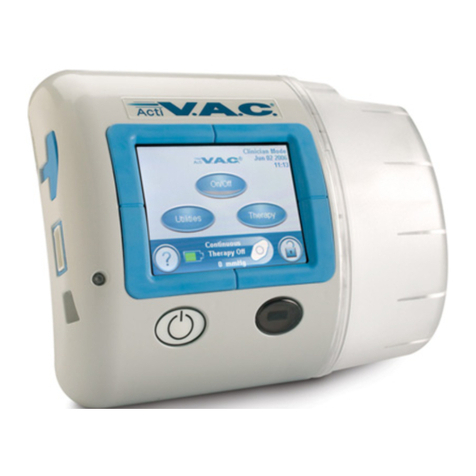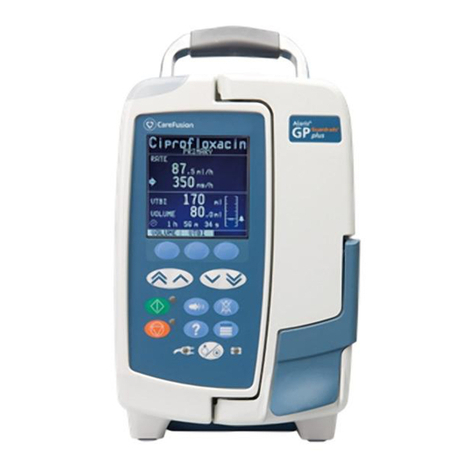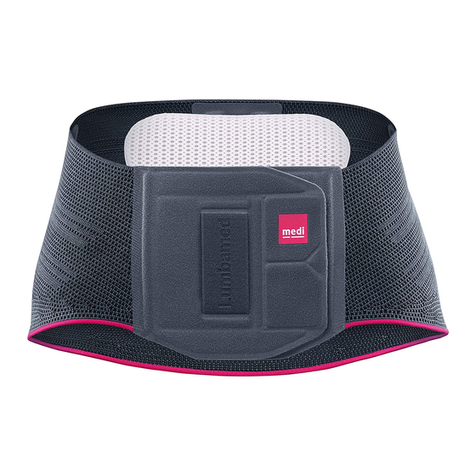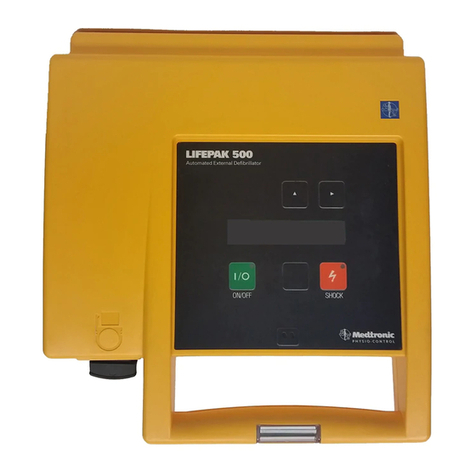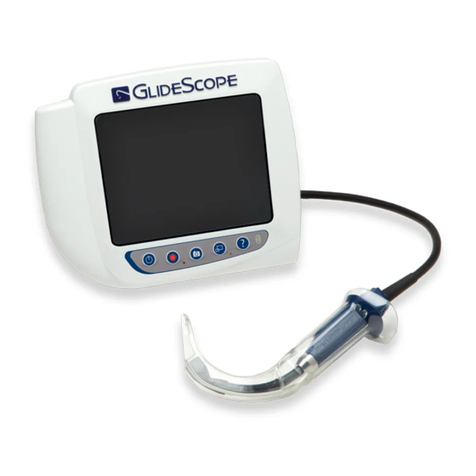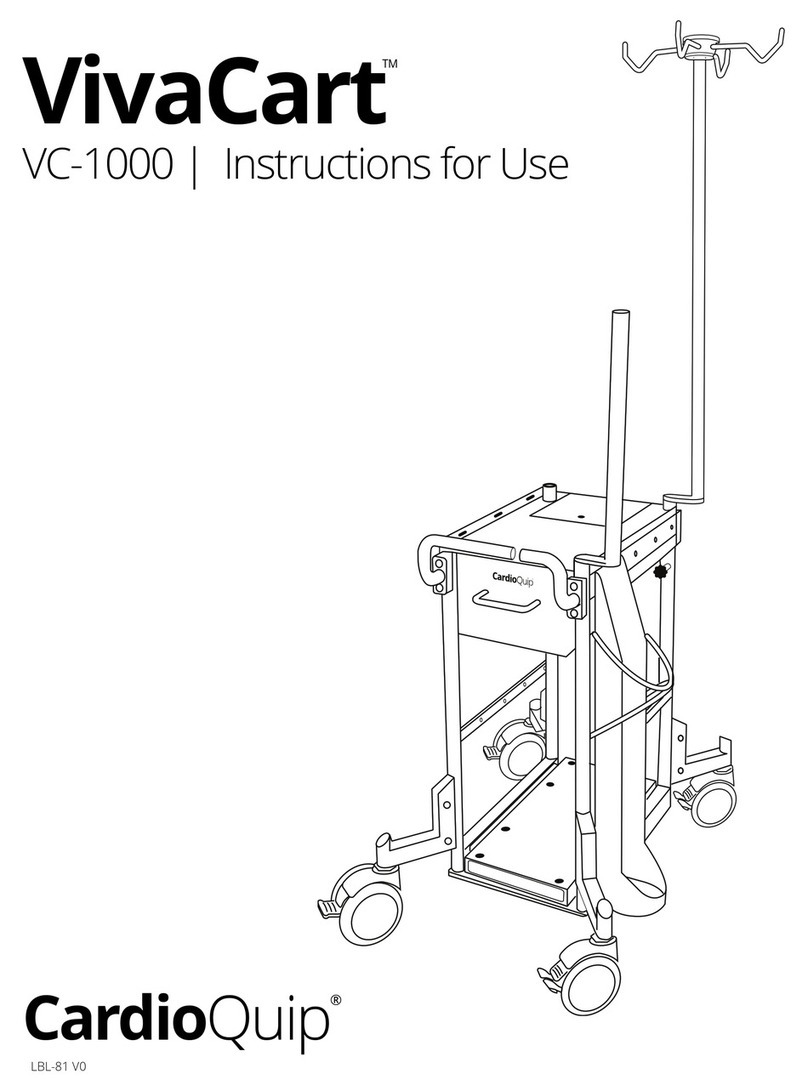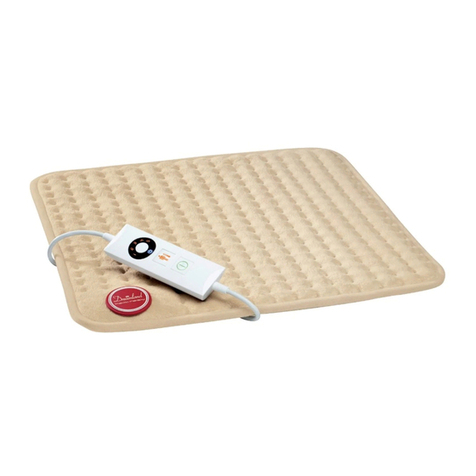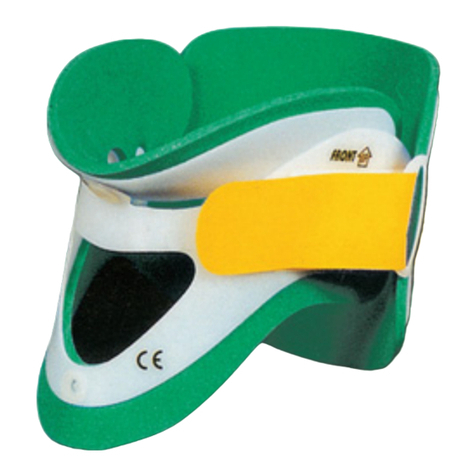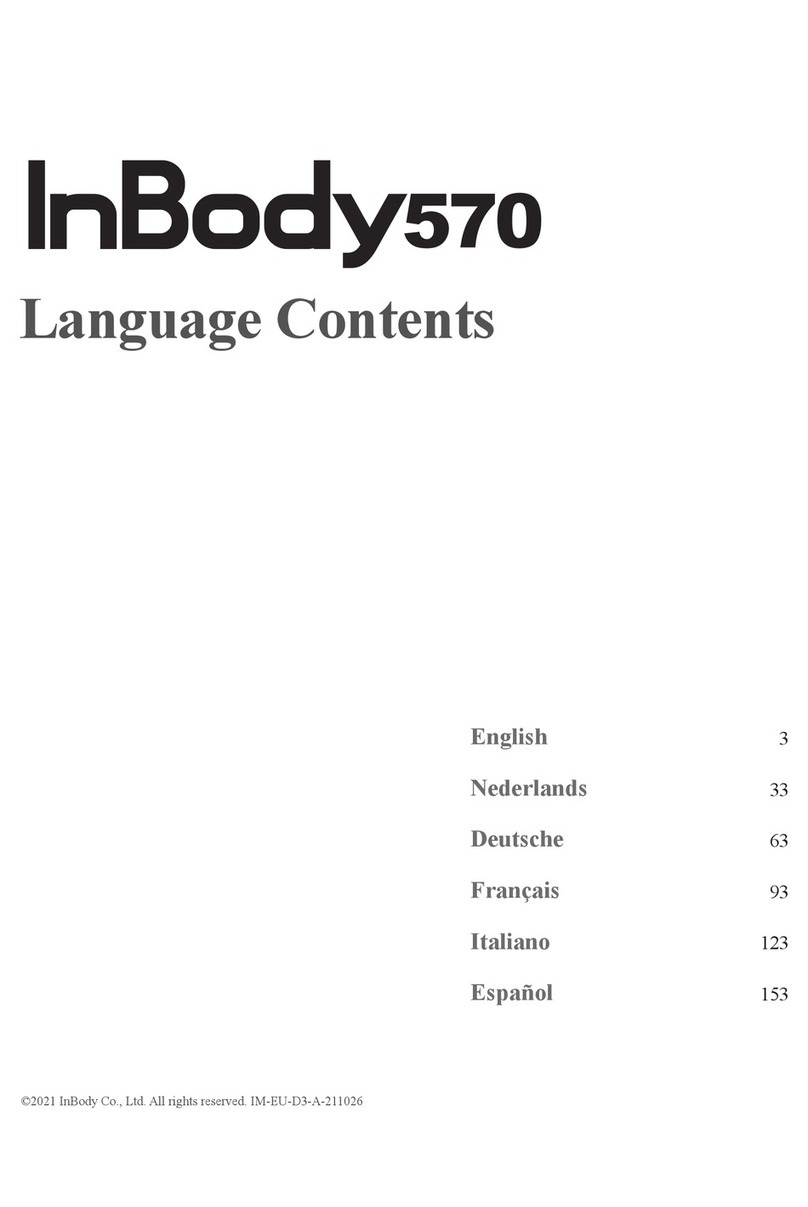HILOTHERM ChemoCare-CIPN User manual

Instructions for use HILOTHERM HT02 ChemoCare-CIPN
HT02 ChemoCare CIPN englisch 2022-02-10 cs - 1 -
ChemoCare-CIPN
Instructions for use
HILOTHERM GmbH
Wittumweg 38
D-88260 Argenbühl Iron Resin
Phone +49 / 75 66 / 9 11 99
0123

Instructions for use HILOTHERM HT02 ChemoCare-CIPN
HT02 ChemoCare CIPN englisch 2022-02-10 cs - 2 -
Table of contents
1.General description9.Cuffs
1.1 Purpose 9.1 Variants and material properties
1.2 Usages of application 9.2 Warning notes
1.3 Indications and contraindications 9.3 Product use
1.4 Requirements for operators 9.4 Risk classification
1.5 Device description 9.5 Application description
9.6 Storage, storage and Transport
2.Safety instructions 9.7 Defection, cleaning and
2.1 General safety instructions 9.8 Control and testing
2.2 Hazard warningsDrying 9.9 Packaging
2.3 Electromagnetic compatibility 9.10 Sterilization
2.4 Environmental conditions
10.Annex
3.Commissioning Aguidelines and manufacturer's declaration
3.1 Functional control B declaration of conformity
3.2 Establish
3.3 Operation and after water change
3.4 Filling and switching on
3.5 Set temperature
3.6 Connecting the cuffs
3.7 Ending
3.8 Failures
3.9 Menu
4.Cleaning and disinfection
4.1General
4.2.Device surface
4.3Cots
5.Maintenance, inspection
5.1 Replace water filters and change water
5.2 Cleaning heat exchangers
5.3 Grease plug connections
5.4 Review
5.5 Safety control
5.6 Liability
5.7 Warranty
6.Storage, transport, disposal
6.1 Storage
6.2 Transport
6.3 Displacement
7.Technical data
7.1 Technical data
7.2 Characters
7.3 Security standards
7.4 Discussions and troubleshooting
8.Accessories and spare parts

Instructions for use HILOTHERM HT02 ChemoCare-CIPN
HT02 ChemoCare CIPN englisch 2022-02-10 cs - 3 -
Before commissioning the Hilotherapy system, the instructions for use must be read. Pay
particular attention to the caution and warning instructions.
Cautiondescribes a situation in which the device or connected modules can be damaged.
Caution/ Warningdescribes a situation in which people may be harmed.
Increased attention and care should be applied.
1. General description
1.1 Purpose
HILOTHERAPIE using the Hilotherm ChemoCare System is a form of physical thermotherapy that
uses a constant temperature in the range of 5°C to 25°C locally. Applications lasting several hours
can be carried out without temperature deviations. Used prophylactically, HILOTHERAPY with
ChemoCare significantly reduces the risk of chemotherapy-induced polyneuropathy (CIPN) –
also known as hand-foot syndrome (HFS).
Principle of action:
In chemotherapy, parts of the chemotherapy drug are directed via the sweat glands to the surface of
the skin, where "free radicals" form in contact with oxygen. These damage the tissue cells of the skin,
especially where it is particularly thick as a cornea and absorbs the substance like a sponge >> on
the palm and sole of the foot.
To prevent the chemotherapy drug from penetrating into the capillaries of the extremities, it is
necessary to slow down blood circulation and metabolism. This is done by lowering the tissue
temperature.
With the Hilotherapy system Hilotherm ChemoCare consisting of the temperature control devices "as
well as hand and foot cuffs, the tissue temperature is locally adjusted in the area of hands and feet to
an individual value prescribed by the doctor and kept constantly cool.
The therapy device with the cuffs and connection tubes forms a closed circulatory system through
which the cooling medium flows and keeps the set temperature constant.
1.2 Areas of application
Thermotherapy with the "Hilotherm ChemoCare" is used prophylactically before and during
chemotherapy to reduce the risk of chemotherapy-induced polyneuropatia.
Duration of use
The use of thermotherapy should be carried out half an hour before the start of therapy and during
chemotherapy.
1.3 Indications and contraindications
Indications for hilotherapy
Indication for hilotherapy (localized lowering of tissue temperature) is chemotherapy-induced
polyneuropathy (CIPN)
A common complication of chemotherapy with certain cytostatic drugs, such as.B. carboplatin,
capecitabine, 5-Fu, cyclophosphamide, cytarabine, docetaxel, doxorubicin, oxaliplatin, paclitaxel,
sorafinide and sunitinib, is hand-foot syndrome.
This refers to side effects on the hands and feet that can occur both shortly after the start of
chemotherapy or only in the course or months later.
The symptoms are: numbness in the hands and feet with gait uncertainty, decrease in tactile
sensation, loss of depth sensitivity, loss of temperature perception, burning pain, disturbance of
coordination as well as hypersensitivity of the skin, e.B. when touched.

Instructions for use HILOTHERM HT02 ChemoCare-CIPN
HT02 ChemoCare CIPN englisch 2022-02-10 cs - 4 -
Contraindications to hilotherapy
Contraindicated are all forms of cold applications in the presence of cryoglobulinemia, cold
hemagglutination and cold urticaria / cold contact urticaria caused by histamine release.
Hilotherapy is also not indicated for diseases in the area of functional circulatory disorders (e.B.M.
Raynaud's disease), severe arterial occlusive disease, pronounced sensitivity disorders and trophic
tissue lesions.
1.4 Requirements for operators
The operation of the Hilotherapy device is simple and can be carried out by nursing staff or the patient
himself. However, the application should be supervised by qualified medical personnel.
Before commissioning, the instructions for use must be known and the operator must familiarize
himself with the device. In particular, the application of the cuffs must be done carefully.
1.5 Device description
The Hilotherapy System HT 02-c is a transportable system for local professional cold treatment. It
consists of 2 cooling units, a transport trolley and corresponding cuffs for hand and foot cooling.
It is characterized by its easy handling and easy operation.
The temperature is adjustable from + 5°C to 25°C
The device is intended for continuous operation.
The Hilotherapy cooling unit essentially consists of the following components:
Cooling unitWith the cooling unit, distilled water is tempered to the exact degree and kept constant.
ControlThe controller records the data in the device via sensors and regulates all processes. With the
keys (item 04) the desired value for the temperature is entered.
DisplayThe display (item 03) shows the set values and the operating status.
The following describes the use of a cooling unit of the ChemoCare system. The two cooling
units of the HILOTHERM ChemoCare System are identical and can therefore be operated in the
same way.
01 Clutches
02 Feeding tube
03 Display
04 Keyboard
05 Level indicator and drain
pants
06 Ventilation slots
07 Carrying handle
01
1
02
1
05
1
04
1
03
1
06
1
07
1
Fig. 1

Instructions for use HILOTHERM HT02 ChemoCare-CIPN
HT02 ChemoCare CIPN englisch 2022-02-10 cs - 5 -
2. Safety instructions
2.1 General safety instructions
•Before commissioning, the user must check the correct condition of the device and user part.
•The therapy facility always consists of the Hilotherapy device, connecting tube and cuff(s).
•Only original Hilotherapy devices and cuffs may be connected and used.
•When switched off, the good thermal conductivity of water can lead to an unwanted change in
body temperature in large cuffs (cooling when applying heat, heating when applying cold).
•If the intended use cannot take place due to malfunctions, the cuff must be removed.
•During application, especially when using several or large cuffs, the patient's body temperature
should be monitored.
•The hilotherapy system must not be operated in the incubator.
•The cuffs can be damaged by the penetration of sharp objects.
•The flow of the channels in the cuffs can be prevented by folding the cuffs or by pressing.
•The flow of the hoses can be prevented by buckling.
•The tank may only be filled with demineralized water.
•When filling with demineralized water, the power plug must not be plugged in.
•The lateral ventilation slots must not be closed or covered. The device may only be operated in a
horizontal position on a fixed flat surface.
•The device must not be put into operation if not all aggregates and displays are working properly.
•In the event of malfunctions, the device must be switched off immediately. It may only be used
again when the fault has been resolved. In the event of critical or unclear errors, the manufacturer
must be notified.
•Interfaces for the service area and data exchange must not be used when a patient is connected
to the device.
•Warning: Changing the device is not allowed
2.2 Hazard statements
•The housing must not be opened.
•Before carrying out maintenance measures, the device must be disconnected from the power
supply.
•Maintenance may only be carried out by qualified service technicians.
•The AC voltage source shall correspond to the specified range located on the nameplate on the
back of the device.
•The Hilotherapy system may only be connected to mains voltages connected to a reliable
protective mass conductor. Do not use the system if the functionality of the external, protective
mass conductor is questionable.
•In order to ensure fire protection, care must be taken when replacing the fuses that only fuses of
the same type and with the same nominal values are used (see type plate).
2.3 Electromagnetic compatibility
In the case of medical electrical equipment, special attention must be paid to electromagnetic
compatibility (EMC). This means that the devices must be installed and put into operation in
accordance with the EMC instructions contained in these operating instructions (see instructions and
manufacturer's declaration in the annex).
Portable and mobile radio communication equipment can affect medical equipment.
Warning: The Hilotherapy system should not be operated alongside/on other equipment. Should this
be necessary, the hilotherapy system must be monitored to ensure safe operation.
2.4 Environmental conditions
The ambient temperatures for safe operation are between + 10 °C and + 26 °C.

Instructions for use HILOTHERM HT02 ChemoCare-CIPN
HT02 ChemoCare CIPN englisch 2022-02-10 cs - 6 -
At higher temperatures, the guaranteed cooling capacity cannot be provided. If the device has been
exposed to temperatures that are far outside the specified temperature range, it should be waited
before commissioning until the device has reached room temperature.
The humidity in the room should not exceed 70%. Higher humidity can lead to condensation on the
hoses and cuffs.
Caution: Accumulation of condensation can lead to a risk of slipping on the floors. If this is detected,
appropriate security measures must be initiated
Protect the device from excessive heat, dust and direct sunlight.
Warning: The Hilotherapy system is not intended for operation in highly explosive environments and
must be kept away from flammable gases and liquids.
3. Commissioning
3.1 Functional control
Before commissioning the Hilotherapy system, devices and user parts must be checked for damage
(see Chapter 2. Safety instructions).
Caution: The system may only be put into operation if all components are undamaged.
3.2 Installation
•The Hilotherapy system with trolley set up on a horizontal, flat, hard surface.
•These devices must be set up in such a way that air circulation is not impeded.
•A minimum distance of 20 cm on the side and 10 cm on the top must be maintained to other
devices or furniture.
•The system must be set up in such a way that disconnection from the power grid is not made
more difficult.
•Make sure that the device vents are not directed at the patient.
3.3 Initial commissioning and after water change
Attention: During initial commissioning and after water change, the pump system must be vented
before switching on the Hilotherapy device.
•To vent, insert the vent syringe with the plug-in sleeve onto one of the front clutches.
•Pull out the air with the syringe.
•Remove the vent syringe.
Caution: During initial commissioning or after the water change, the device must only be switched on
with the cuff connected so that the air can escape from the pump system and the pump does not run
dry.
If the pump starts up and no water is pumped into the cuff, the pump must be vented again.
3.4 Filling and switching on
•Fill the water container with demineralized water. The level
indicator should be located at the "max" marker.
ATTENTION: In the cold unit that supplies the foot cuff of
the 2nd generation, the water level of the device must be
filled exactly to the "max" mark before filling the cuffs.
Otherwise, the water level message "E21" appears and some
water must be refilled (about 1 cm on the display scale). If there is
too much water in the device, there may be an overflow in the
filling funnel of the device after switching off the device and the

Instructions for use HILOTHERM HT02 ChemoCare-CIPN
HT02 ChemoCare CIPN englisch 2022-02-10 cs - 7 -
associated return from the cuffs.
•During initial commissioning and after water change, ventilate the pump system, see 3.3.
•Plug in the power plug.
•Turn on the device at the main switch on the back of the device. When switched on, the device
checks itself. At the end of the self-test, an acoustic signal sounds and the menu appears on the
display, see 3.9.
•Connect the connection hose and the cuff.
•Set the desired set temperature.
•Press the button.
•Make sure that water is pumped through the cuff.
3.5 Setting temperature to cuff type
•The desired target temperature during the application is displayed on the display.
Changed the arrow keys (for higher) and (for lower).
•The set value is automatically applied and the Hilotherapy device changes the actual temperature
to the desired value.
For the cooling of the hands and feet, both first-generation cuffs (1stgeneration) and second-
generation cuffs (2nd generation) can be used.
Cuffs of the 2nd generation have the property of a more efficient cold transmission and thus achieve
an even better CIPN prevention result. In addition, when using the 2nd generation cuffs, the set
temperature can be set higher and thus more pleasant:
Cuffs of the first generation (1st generation)
Second generation (2nd generation) cuffs:
The following device settings are recommended:

Instructions for use HILOTHERM HT02 ChemoCare-CIPN
HT02 ChemoCare CIPN englisch 2022-02-10 cs - 8 -
3.6 Connecting the cuffs and hose attachment
•Cuff and connection hose are connected (audible snapping of the locking grommets into the
couplings).
•The hose is plugged into the couplings with the locking grommets (Fig. 1).
•The swapping of feed and return is permissible and does not lead to malfunctions.
•When putting on, make sure that the cuffs are not placed over sharp edges or pointed objects.
•The uncoupling of the cuffs is carried out by retracting the gripping ring.
3.7 Exit
•Pressing the button terminates the operation.
•At the main switch on the back, the device is switched off.
•If the device is not used for a long time, it must be disconnected from the supply network by
unplugging the mains plug.
3.9 Faults
Disturbances are indicated by an optical and/or short acoustic signal.
The cause of the disturbance is described in item 7.4.
3.10 Menu
Turn on the device
Main switch on
Device cools / heats
Pressure pump off
Device is in operation
Device cools
Pressure pump running
The temperature can be changed in both operating states.
A flashing snowflake means that the device is in the cooling phase into the temperature target
range. If the snowflake appears permanently, the cooling temperature of the device is in the
target area.
Device operation –
exclamation point flashing quickly
The cooling temperature no longer comes
to the finish area
For troubleshooting, see item 7.4.

Instructions for use HILOTHERM HT02 ChemoCare-CIPN
HT02 ChemoCare CIPN englisch 2022-02-10 cs - 9 -
Diagnosis
If an error occurs, the "E" indicator appears. Only the current error is displayed. The display can
only be deleted when the error has been resolved.
For troubleshooting and troubleshooting measures, see item 7.4.
4. Cleaning and disinfection
4.1 General
Caution: The device must only be cleaned after it has been disconnected from the power supply. No
sharp objects may be used for cleaning.
4.2 Device interface
Surfaces and equipment parts can be cleaned and disinfected with the usual and approved cleaning
and surface disinfectants in the hospital sector.
Make sure that no liquids get into the device, especially through the vents on the sides.
4.3 Cuffs / user parts
Listed separately under point 9.7
5. Maintenance, inspection, safety control
The Hilotherapy system has been designed and manufactured to the highest quality standards.
When used as intended and carried out the intended maintenance and service measures, the device
achieves a service life of 10 years and more.
In order to ensure the safety and functionality of the Hilotherapy system for a long time, the following
maintenance measures must be carried out:
5.1 Replace water filters and change water –at least every 6 months
•Lift out the grid in the hopper with a small screwdriver.
•Remove the filter.
•Pull the hose of the water level indicator out of the guide on the housing.
•Remove the cover plug.
•Drain water completely.
•If necessary, rinse the tank with surface disinfectant (e.B. Kohrsolin FF or Mikrobac from Bode
Chemie) and rinse with fresh distilled water.
•Push the drain hose back into the guide of the housing.
•Press in the cover plug.
•Insert a new filter.
•Place the grid back over the filter.
•Fill with demineralized water via the filling hopper, to which a preservative can be added.
•Vent the device (see point 3.3).
5.2 Clean heat exchangers –at least every 6 months or in case of visible contamination
Dust deposits on the heat exchanger reduce the cooling capacity of the device.

Instructions for use HILOTHERM HT02 ChemoCare-CIPN
HT02 ChemoCare CIPN englisch 2022-02-10 cs - 10 -
The heat exchanger is located behind the ventilation grille on the right side of the unit.
•Remove the three Phillips screws in the floor under the ventilation grille.
Caution: The screws with hexagon socket must not be loosened!
•Remove the ventilation grille, carefully clean with a soft brush or vacuum cleaner.
Caution: The cooling plates on the heat exchanger must not be damaged!
5.3 Grease plug connections –at least every 6 months
The plug connections of the hoses must be greased regularly so that they are easy to plug in and
ensure complete locking of the locking grommets into the couplings.
•Thinly grease the tips of the closure grommets of the cuff and hose with petroleum jelly.
•Insert and unplug the closure grommets several times into the couplings of the hose or
Hilotherapy device. The petroleum jelly is thus transferred to the O-rings in the couplings.
5.4 Inspection - at least every 2 years
Visual inspection:
•Is the instructions for use complete?
•Is the nameplate complete and legible?
•Are all markings and stickers on the device correct and legible?
•Are all parts fixed to the device (no parts loosened)?
•Is the housing undamaged?
•Are the connectors for the cuff connection smooth and undamaged?
•Do all switches and buttons work properly?
•Is the main backup in the device the specified type?
•To change the fuse, pull out the slot between the main switch and the device plug. After changing
the fuse, press the slot until it clicks into place audibly.
•Is the device plug with main switch undamaged?
•Is the power cord undamaged?
•Are the device and accessories clean?
•Are the ventilation slots and the heat exchanger behind them clean?
•Is the accessory in perfect condition?
•Replace the water filter and distilled water.
Testing:
•Function of the cooling unit
•Function of the pressure pump (Are the cuffs sufficiently supplied?)
•Is wear and tear recognizable? (unusual noises?)
•Function of the water level sensor (error message water level when switching on with empty
water tank?)
In addition, the following tests can be carried out
•Pressure testing
•Performance tests
In the event of detected defects, the device may not be used again until the defects have been
remedied.
Maintenance measures may only be carried out by qualified personnel.
On request, the manufacturer supports the maintenance personnel through training and technical
assistance.Info
5.5 Safety control
During production, a STK (safety inspection) is carried out as part of the final inspection.
In order to maintain operational safety, a new STK must be carried out when repair work has been
carried out on the electrical system.
The operator is responsible for determining the scope of the test and the test interval (see §11
MPBetreibV). However, the STK must be carried out at the latest every 2 years at the end of the
month.

Instructions for use HILOTHERM HT02 ChemoCare-CIPN
HT02 ChemoCare CIPN englisch 2022-02-10 cs - 11 -
5.6 Liability
HILOTHERM GmbH (as the manufacturer) is only liable for the effects on the safety, reliability and
functionality of this device if:
•Assembly, extensions, new hires, modifications or repairs are carried out by authorized persons
of the manufacturer.
•the parts and components used for repairs, modifications, extensions or local applications are
approved by the manufacturer.
•the electrical installation to which the device is connected complies with the regulations of the
local authorities.
•only the accessories approved by HILOTHERM GmbH are used.
•the device is used in accordance with the instructions for use.
5.7 Warranty
With regard to liability for material defects, the provisions of German law shall apply. This does not
affect the statutory provisions of the Product Liability Act.
6. Storage, transport, disposal
6.1 Storage
The device should be stored dry and horizontally on flat ground, at a temperature of 5°C to 40°C and
10 –70% RH and air pressure of 700 hPa –1060 hPa.
Caution: If the device is stored below 0°C, the water of the cooling circuit must be completely
emptied to avoid damage caused by freezing.
6.2 Transport
Before transport, the device must be completely emptied.
Caution: The device may only be transported on pallet with a forwarding agent , as
horizontal transport is absolutely necessary.
6.3 Disposal (WEEE Reg.-Nr. DE 25202195)
The device must not be disposed of with general commercial or household waste.
In accordance with product responsibility according to § 22 of the Recycling and Waste Management
Act and the Electronics Act § 2.2 paragraph 1, the device must be handed over to a corresponding
municipal collection point or returned .dem manufacturer.
When disposing of it, it should be noted that the appliance contains a refrigeration unit similar to a
refrigerator (refrigerant: R134a).
Warning: There is oil in the compressor unit.
7. Technical data
7.1 Technical data
Type HT02 ChemoCare-CIPN
Article No. 2020 0012
Rated voltage 230 VAC 50 HZ
Power consumption max.320 VA
Current consumption 2.5 A
Fuse value 2.5 A 250 V
Protection class I
Degree of protection application part B
Protection class IP 20
Risk class (93/42 EEC) IIa

Instructions for use HILOTHERM HT02 ChemoCare-CIPN
HT02 ChemoCare CIPN englisch 2022-02-10 cs - 12 -
Dimensions 430 mm x 275 mm x 268 mm
Weight 10 kg
Cuff connections 2
Capacity water tank min.1.25 liters, max. 2.25 liters
Temperature range + 5°C to + 25 °C
Control/setting tolerance ± 1°C
Refrigeration unit
Rated voltage 230 V 50 HZ
Working pressurePü zul. 25 bar intrinsically safe
Refrigerant R 134a
Capacity100 g
Positive displacement pump
Rated voltage 15 V
Operating pressure 0.5 bar +0.1
Heating
Rated voltage 230 V
Power consumption 220 VA
Ambient conditions
Storage temperature minimum. + 5 °C, max. + 40 °C
Humidity storage 10 - 70% RH non-condensing
Operating humidity 10 - 70% RH non-condensing
Operating ambient temperature + 10 °C to + 26 °C
7.2 Characters
The following characters can be found on the device and on the packaging:
General warning sign. The device calls physiological effects
(temperature changes) that are not obvious to the operator
are.
Filling device, demineralized water filling
Drain device
Follow the instructions for use
see accompanying documents (instructions for use)
Manufacture
(YYYY)
Device type B
(Protection against electric shock)
CE marking for conformity according to EU Directive 93/42/EEC
Medical devices with marking of the certification body
0123
2
not for reuse /
Use only once
do not dispose of general commercial or
household waste
AQUA DEST.

Instructions for use HILOTHERM HT02 ChemoCare-CIPN
HT02 ChemoCare CIPN englisch 2022-02-10 cs - 13 -
7.3 Safety standards
Classification
According to the classification criteria in Annex IX EC Directive 93/42 EEC, the hilotherapy system is
to be classified in Class IIa Rule 9 (Active medical device for therapeutic purposes).
According to the GMDN classification, the device is assigned to No. P 42463, the Cuffs No. P
44604.
The Hilotherapy system is neither assigned to Appendix 1 and 2, nor to Appendix 3 of the
MPBetreibV.
Standards and guidelines
EC Council Directive 93/42/EEC on medical devices of 14 June 1993
Medical Devices Act MPG of 02 August 1994
DIN EN 60601-1
DIN EN 60601-1-2
DIN EN ISO 10993-1
HILOTHERM GmbH reserves the right to change specifications without notice.
7.4 Faults and troubleshooting
Error
Possible cause
Measures
Device without function,
no display on the display
1. Power failure
2. Fuse defective
3. Fuse repeatedly defective
4. Power plug does not have a
power plug
Contact
5. Device defective
1. Turn off the device
2. Replace the fuse
3. Customer Service
4. Plug connection of the mains
connection
Check the line
5. Customer Service
Device does not cool
1. Heat exchanger with dust
Added
2. Device defective
1. Heat exchanger carefully with
Vacuum cleaner or soft brush
clean.
2. Customer Service
Display Anzeige
Fast flashing snow symbol
with exclamation mark
The cooling water is outside
the ideal temperature range
for the application (too warm)
1. Heat exchanger with dust
Added
2. Device defective
3. Ambient temperature too
high
1. Open the right-sided blue housing
cover and carefully clean the heat
exchanger with a vacuum cleaner
or soft brush.
2. Customer Service
3. Operate the device in the specified
temperature range
Note: Cooling is still possible and should
be continued
No or too little water
circulation
1. Pump is not vented
2. Hoses or cuff
snapped off
3. Clutch not engaged
4. Pump defective
1. Venting, see section 3.3
2. Eliminate the kink
3. Press in clutches until they lock
audibly
4. Customer Service
Display Display
"E21"
1. too little water in the tank
2. Level sensor is fixed
1. Refill demineralized water
2. Drain and fill repeatedly
Display Display
"E11"
Pumpe defect
1. Technischer Service
Display Display
"E01"
Temperature difference
between the two temperature
sensors detected.
1. Recalibration/Reset
2. If 1 is not successful then inform
Technical Service
Display Display
"E02"
Temperature sensors not
connected / cable break
1. . Recalibration/Reset
2. If 1 is not successful then inform
Technical Service

Instructions for use HILOTHERM HT02 ChemoCare-CIPN
HT02 ChemoCare CIPN englisch 2022-02-10 cs - 14 -
Display Display
"E03"
Temperature too low < 3°C
1. Recalibration / Reset
2. If 1 is not successful, check the
ambient temperature
Let the device warm up
Display Display
"E04"
Temperature too high > 42°C
1. Recalibration
2. If 1 is not successful, check the
ambient temperature. Allow the device
to cool down
Display Display
"E05"
Increased temperature
difference between the two
temperature sensors detected
1. . Recalibration/Reset
2. If 1 is not successful then inform
Technical Service
Display Display
"E99"
Control system defekt
1. Inform technical service
Plug connection of the hoses
is difficult
1. O-ring is not greased
2. Plug connection is
damaged
1. Easily grease the spout with
petroleum jelly
2. Customer Service
Attention: Opening the device leads to the loss of warranty claims!
Exception: Right-sided blue housing cover for cleaning the
heat exchanger
Hint:
In the event of an E0x temperature error , resetting the
temperature system settings can fix the problem.
This reset is done by pressing all 3 buttons
(up, down and enter) at the simultaneously switching on the
device on the power switch of the back of the device.
After the reset, turn the device off and on again on the power
adapter
.
A successfully performed reset can be recognized by the fact
that the operating hours on the start display are set to "0h".
8. Accessories and spare parts
All spare parts and accessories are available from HILOTHERM GmbH or an authorized dealer.
Accessories
Only original HILOTHERM accessories may be used.
Caution: The use of other devices or accessories in conjunction with the Hilotherapy device is not
permitted.
Standard accessory list per device:
Number
Article
Designation
1
40000332
Power cord (C,F 230V 50 Hz)
2
40000259
Connection hose
1
40000379
Vent set
Spares
Only original spare and wear parts guarantee device safety and reliability.
The replacement of parts may only be carried out by qualified persons.
The hilotherapy system is constantly evolving.
To ensure that you always receive the right spare part even after technical changes, we ask you to
provide us with the following data with each order:
Designation: Type HT 02Series number....................
Year of construction....................

Instructions for use HILOTHERM HT02 ChemoCare-CIPN
HT02 ChemoCare CIPN englisch 2022-02-10 cs - 15 -
9. Cuffs
9.1 Variants and material properties
For the Hilotherm ChemoCare System, the following cuffs are to be used for thermotherapeutic
application in anatomically adapted form:
•Hand cuff
•Foot cuff slippers
Material properties:
Cuff film: TPU (thermoplastic polyurethane) –latex-free, silicone-
freeTuff
insulation TPU foam
Hose insulation (for MM sleeves) TPU foam
Hose: TPU (thermoplastic polyurethane)
Closure grommet: Brass, nickel-plated / POM
9.2 Warnings
•The cuffs may only be used in conjunction with the Hilotherapy device.
•The cuffs must not come into contact with chemicals containing benzene and phenol.
•Before each application of the cuff, it must be checked for integrity (no blistering, no leakage).
Only intact cuffs are to be used. If abnormalities occur during treatment, such as .B blistering or
leakage, the application should be discontinued immediately. In the event of defects in the hose
and capillary system of the cuffs, these must be discarded.
•When handling the cuffs, care must be taken to ensure that they are not damaged by sharp
objects.
•Care must be taken to ensure that the flow of the channels in the cuffs is not prevented by folding
the cuffs or by pressing.
•When coupling and uncoupling the closure grommets of the hose system to the Hilotherapy
device, a few drops of water may escape. It must be ensured that these do not get on wound
dressings and bandages! The cuff may only be applied to intact skin or wound dressings.
•Water escaping due to any leaks usually does not pose any hygienic hazard to the user with a
predetermined water change and regular maintenance and cleaning of the
system.
9.3 Use of the product on the patient / intended purpose
The cuffs are used exclusively for external use.
The application to corresponding skin areas is carried out on wound dressings or directly on intact
skin.
For repeated therapeutic use, we recommend the patient-related assignment of a cuff.
EM cuffs are intended for single use per patient and must not be reprocessed. With these EM cuffs,
a yellow or blue-green coloration of the cuff material may occur when used over a longer period of
time. This discoloration is material-related and does not pose any hygienic hazard to the user.
9.4 Risk classification of medical devices according to RKI
The risk assessment and assessment is based on the Federal Health Gazette 44 (2001): 1115-1126:
Requirements for hygiene in the reprocessing of medical devices.
The operator is responsible for the implementation of the treatment measures by qualified personnel
and with appropriate validated procedures.
The individual steps of the preparation must be adapted to
•the medical device
•processing

Instructions for use HILOTHERM HT02 ChemoCare-CIPN
HT02 ChemoCare CIPN englisch 2022-02-10 cs - 16 -
•the application on the patient.
The cuffs are intended only for contact with intact skin. Pathologically altered skin areas (e.B.
abrasions, infectious wounds) or surgical wounds must be provided with a wound dressing before
treatment.
With regard to the type of application of the cuffs and the resulting risk, they are classified as
uncritical medical devices.
9.5 Application description
When coupling and uncoupling the closure grommets of the hose system to the Hilotherapy device, a
few drops of water may escape. It must be ensured that these do not get on wound dressings and
bandages!
The filled cuff is loosened without exerting pressure on the part of the body to be treated. Fixation
measures may be necessary.
The duration of the treatment depends on the instructions of the attending physician.
9.6 Storage, storage and transport
The cuffs are delivered with low germs in a transport and dust protection bag and in an additional
outer carton.
Storage must be dust-free, dry, without exposure to UV radiation and without temperature fluctuations
at room temperature.
9.7 Disinfection, cleaning and
dryingCots, appliances and accessories are manufactured in a clean and hygienically harmless
condition and delivered accordingly. However, the condition of the products mentioned in the
delivery state cannot be specified as "sterile".
9.7.1 Cuffs
Cuffs labelled as single patient use cannot be reprocessed and are intended only for use during
treatment on a patient.
Disinfection may be required before applying the cuffs to wound dressings or to the part
of the body to be treated, depending on the instructions of the attending physician.
Reprocessing / Duration of use
Cuffs that are not labeled as disposable can be cleaned, reprocessed and disinfected. This also
applies to multiple sleeves that are provided with PU foam insulation on the outer surfaces.
With proper processing and depending on the frequency of use, multiple cuffs can be used over a
period of about one year.
Due to frequent use of the multiple sleeves and the reprocessing process, the cuffs are subject to
wear caused by the application. Wear-related defects and defects in the cuffs are not subject to any
warranty claims
Cleaning and disinfection procedures
The manual cleaning and disinfection of the cuffs must be carried out after treatment on the patient
with conventional and approved cleaning and surface disinfectants in the hospital area.
Corresponding information such as the list of approved disinfectants and recommendations for
disinfection procedures can be found on the website of the Robert Koch Institute (www.rki.de)
Wipe disinfection is recommended for the smooth surfaces of the cuffs, and wipe or spray disinfection
for surfaces with a material-like surface (blue insulation). Disinfection must be carried out by qualified
personnel.
The cuffs as well as the insulation are made of poleurethane, this material is well tolerated with a
variety of disinfectants. With regard to compatibility, concentration and exposure time of the
disinfectant, the respective manufacturer's instructions must be observed.
If properly carried out, multi-cuffs can be reprocessed over a period of about one year.

Instructions for use HILOTHERM HT02 ChemoCare-CIPN
HT02 ChemoCare CIPN englisch 2022-02-10 cs - 17 -
A hygiene and disinfection plan with corresponding process descriptions and work instructions as part
of the quality management must be drawn up by the operator in order to be able to document a
comprehensible and validated treatment process.
Example of a mechanical cleaning and disinfection of non-critical medical devices
Cleaning, disinfection, rinsing and drying is possible in a cleaning and disinfection machine with a
validated chemical or chemical-thermal process at a maximum of 55 °C. The cuff must be fixed within
the device chamber in suitable holders in such a way that the film surface can be easily rinsed by the
cleaning and disinfection media. The procedure should be followed by automatic drying in the device.
The application of the mechanical process must be carried out by qualified personnel in accordance
with the specifications of the quality management (e.B. process description, work and procedure
instructions) of the operator.
9.7.2 Basic device
The surface of the devices consists mainly of ABS plastic and, if necessary, can be ideally treated
by means of wipe disinfection after selecting a suitable method and disinfectant.
A disinfection of the cooling circuit is not necessary if the maintenance specifications and regular
water change are observed.
9.8 Control and testing
After successful disinfection and cleaning, a visual inspection and inspection of the cuffs is required. If
the cuff film, the hoses and / or the closure spouts are damaged, the cuff must be discarded.
Before use on the patient, the cuff should be checked for tightness by connecting it to the Hilotherapy
device and filling it.
9.9 Sterilization
The cuffs cannot be sterilized.

Instructions for use HILOTHERM HT02 ChemoCare-CIPN
HT02 ChemoCare CIPN englisch 2022-02-10 cs - 18 -
10. Annex
A Guidelines and manufacturer's declaration
A1
Table 1 (EN 60601-1-2)
Guidelines and manufacturer's declaration - Electromagnetic emissions
The Hilotherm Chemocare is designed to operate in an electromagnetic environment as
specified below . The customer or user of The Hilotherm Chemocare should ensure that it
operates in such an environment.
Emission measurements
Agreement
Electromagnetic
Environment Guide
RF mailings to
CISPR 11
Group 1
The Hilotherm Chemocare
uses RF energy exclusively
for its internal function.
Therefore, its RF emission is
very low and it is unlikely that
neighboring electronic
devices will be disturbed.
RF mailings to
CISPR 11
Class B
The Hilotherm Chemocare is
suitable for use in all
facilities, including those in
the residential area and
those directly connected to a
public utility network that
supplies buildings used for
residential purposes.
Transmission of harmonics
according to IEC 61000-3-2
Class A
Emission of voltage
fluctuations/flicker according to
IEC 61000-3-3
jibes
A2
Table 2 (EN 60601-1-2)
Guidelines and Manufacturer's Declaration - Electromagnetic Immunity
The Hilotherm Chemocare is designed to operate in the electromagnetic environment specified
below. The client or user of the Hilotherapy system should ensure that it is used in such an
environment.
Immunity tests
IEC 60601 - Test
level
Match tuning
level
Electromagnetic
Environment - Guidelines
Discharge of static
electricity (ESD)
according to IEC
61000-4-2
± 6 kV contact
discharge
± 8kV air discharge
± 6 kV
Contact
discharge
± 8 kV air
discharge
Floors should be made of
wood or concrete or provided
with ceramic tiles. If the floor
is provided with synthetic
material, the relative humidity
must be at least 30%.
Fast transient
electrical
disturbances/bursts
according to IEC
61000-4-4
± 2 kV for mains
cables
± 1 kV for input and
output lines
± 2 kV
for power lines
not applicable
The quality of the supply
voltage should match that of a
typical business or hospital
environment.
Surges according
to IEC 61000-4-5
± 1 kV outer
conductor outer
conductor
± 2
kV outer conductor
earth
± 1 kV outer
conductor outer
conductor
± 2 kV outer
conductor earth
The quality of the supply
voltage should match that of a
typical business or hospital
environment.
Voltage breaks,
short conductor
< 5% UT
0% UT
The quality of the supply
voltage should match that of a

Instructions for use HILOTHERM HT02 ChemoCare-CIPN
HT02 ChemoCare CIPN englisch 2022-02-10 cs - 19 -
interruptions and
fluctuations of the
supply voltage
according to IEC
61000-4-11
(>95% drop in UT)
for 1/2period
40% UT
(60% drop in UT) for
5 periods
70% UT
(30% slump in UT)
for 25 periods
5% UT
(95% drop in UT) for
5s
40% UT
70% UT
5000 mS
typical business or hospital
environment. If the user of the
Hilotherm Chemocare
requests continued function
even in the event of
interruptions in the power
supply, it is recommended to
feed the Hilotherm
Chemocare from an
uninterruptible power supply
or a battery.
Magnetic field at
the supply
frequency (50/60
Hz) according to
IEC 61000-4-8
3 A/m
3 A/m
Magnetic fields at the mains
frequency should correspond
to the typical values found in
the business and hospital
environment.
Note: UT is the AC mains voltage before applying the test levels.

Instructions for use HILOTHERM HT02 ChemoCare-CIPN
HT02 ChemoCare CIPN englisch 2022-02-10 cs - 20 -
A3
Table 4 (EN 60601-1-2)
Guidelines and Manufacturer's Statement - Electromagnetic immunity for ME equipment or ME
systems that are not life-sustaining.
The Hilotherm Chemocare is designed to operate in the electromagnetic environment specified
below. The client or user of the Hilotherapy system should ensure that it is used in such an
environment.
Immunity
tests
IEC 60601 - Test
level
Conformity level
Electromagnetic Environmental
Guidelines
Conducted RF
disturbances
according to
IEC 61000-4-6
Radiated RF
disturbances
according to
IEC
61000-4-3
3 V EFFECTIVE value
150 kHz to 80
MHz
3 V/m
80 MHz to 2.5
GHz
U1 = 3 V
E1 = 3 V/m
Portable and mobile radios should be
available at no shorter distance from the
Hilotherm Chemocare including the
cables can be used as the
recommended protective distance,
which is calculated according to the
equation applicable to the transmission
frequency.
Recommended protective distance:
d=[]
1
5,3
V
P
d=[]for 80 MHz to 800 MHz
1
5,3
E
P
d=[]for 80 MHz to 800 MHz
1
7
E
P
with P as the rated power of the
transmitter in watts (W) as specified by
the transmitter manufacturer and d as
the recommended protective distance in
meters (m).
The field strength of stationary radio
transmitters should be lower than the
compliance level at all frequencies
according to an on-site investigation.
Interference is possible in the vicinity of
devices bearing the following figurative
sign.
Note 1: At 80 MHz and 800 MHz, the higher frequency range applies.
Note 2: These guidelines may not be applicable in all cases. The propagation of electromagnetic
quantities is influenced by absorptions and reflections of buildings, objects and people.
a) The field strength of stationary transmitters, such as .B base stations of radio telephones and
mobile land radios, amateur radio stations, AM and FM radio and television stations cannot
theoretically be precisely predetermined. In order to determine the electromagnetic environment with
regard to the stationary transmitters, a study of the site should be considered. If the measured field
strength at the site where the hilotherapy system is used exceeds the above compliance levels, the
hilotherapy system should be observed to demonstrate its intended function. If unusual performance
characteristics are observed, additional measures may be required, such as .B a change in
orientation or a different location of the hilotherapy system.
b) Over the frequency range from 150 kHz to 80 MHZ, the field strength should be less than [V1] V/m.
Table of contents
Other HILOTHERM Medical Equipment manuals

